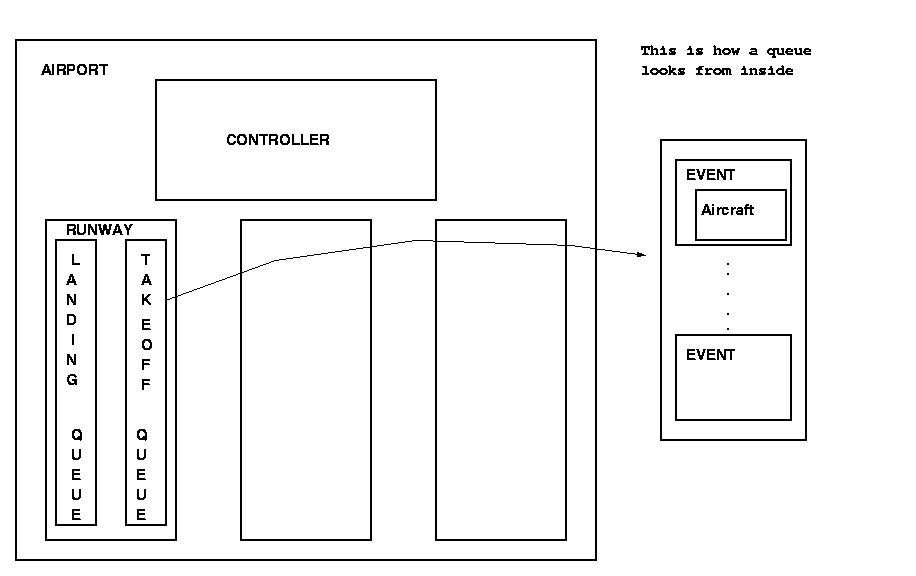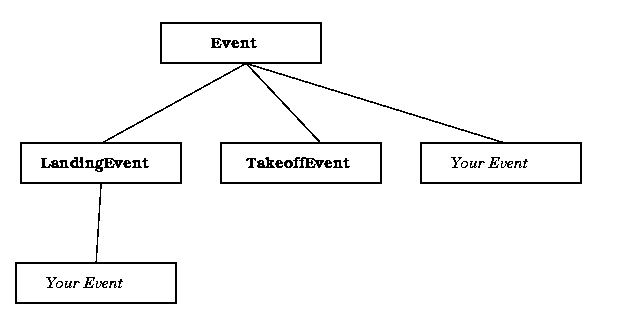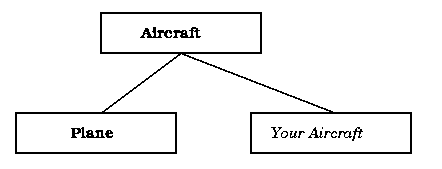
|
CSE 143 Autumn 2000
Homework 5
Due:
Part I electronic submission by 1 pm, Wednesday, Nov 22.
Part I paper receipt due at the beginning of lecture
on Wednesday Nov 22.
Part II (entire assignment) electronic submission 10 pm, Friday,
Dec. 1.
Part II paper receipt due when you meet with your TA to demo your project.
You must do Part I of this assignment by yourself (it is quite short).
You may work with a partner for Part II. If you do, you and your
partner should turn in one assignment with both of your names on it.
|
Overview
In this assignment, you will create a simulation for an airport.
Concepts
The purpose of this assignment is to gain experience with the following new
concepts:
- the notion of a simulation
- queue data structure
- graphics
- event loop
- understanding the provided code
Program Synopsis
This program simulates an airport using graphics, without any necessary
interaction from the user. (Once you are done with the coding, you can just sit
back and enjoy watching your simulation.) Starter code has been provided, and
you will add to it to complete the assignment.
The simulation has one central object, the airport. All the other objects are
contained inside this object. The airport has a set of runways. Each runway has
a takeoff queue and a landing queue. The queues hold the planes waiting to
takeoff and land respectively. (Depending upon the kinds of events you add to
the simulation, you could end up with additional queues.) Each element of a
queue is an event. For the takeoff queue, it is a takeoff event; for the landing
queue, it is a landing event. Each event has an aircraft object associated with
it. There is a controller that keeps the simulation going by generating a
sequence of events. In generating an event, the controller has to do two things:
decide which event to generate (takeoff or landing, and possibly others you
design), and decide which runway to schedule the event on. In the final version
of the program, the controller should make both decisions randomly.
The starter code provided for you creates a single runway and simulates the
takeoff of a single plane on that runway. Once the takeoff is over, the
simulation comes to a standstill. You will be enhancing this code in both parts
of this assignment.
PART I:
Overview: In PART I, you should add the ability to simulate a second runway. In addition, you
should modify the implementation of the queue data
structure used in the code provided to you. You should do all of the
coding for this part by yourself.
What to do
- Read through and become familiar with all of the starter code
provided. Also become familiar with the notion of simulation as realized
in this program. Determine how the different classes are related
to each other. Also, find out what the different member functions do.
- You should have become relatively familiar with GP142 by now
(having used it in HW4). You don't need to acquire a great depth of
knowledge about the functionality of GP142. All you need to be aware of
is what all functions are provided by this package, for which you should
read gp142display.h. This would
be helpful in enhancing the graphics in Part II. For more
information, you can read GP142 or GP143 pages.
- The Queue data structure. At the heart of any simulation, more
often than not, there is a queue data structure. So, there should be no
surprises for you when you find one in this simulation too. The queuein
the starter program is very simple; it has been implemented using just the
front pointer.
In this part of the assignment, you should change this data structure to use a
more efficient implementation that has a front and the rear pointer.
- In order to add another runway, you need to read through the
starter code to find how the single runway is created in the starter
program. You need to add one more runway in a similar manner.
However, even after adding multiple runways to the airport, you will
see just one plane takeoff because currently in the starter code, only
one takeoff event is being generated. (Hint: adding a new runway needs just one line of code)
Part I requirements
- Change the implementation of the queue data structure from the one which
uses just the
front pointer to the one that uses both
front and the rear pointer. In particular, you should
to change the functions EventQueue::enqueue and
EventQueue::dequeue.
- Add one more runway to the airport so there are two runways.
This part is due Wednesday, Nov 22nd.
This finished solution for PART I should work like this: Part I Solution
PART II:
Overview: In Part II, you will complete the simulation. Part II is more
or less open ended. There are a few minimum things that you are required to do
for this part. Beyond that, use your imagination to do something
interesting!! You may work with a partner on this part of the
assignment. If you do work with a partner, the two of you should turn in a
single assignment.
What to do
- Currently, just one takeoff event is generated in the simulation.
Once that event is over, the simulation comes to a stand still. You should
add the ability to generate multiple takeoffs, one after another. For
this, you have to figure out how the single event in the starter code is
generated, then add similar code in the main
event loop at appropriate places to generate multiple takeoffs.
(Hint: cut and paste skills might come in very handy here).
The simulation will look better if you randomly choose when to generate
takeoff events, and which runway to use.
- The next thing to do after getting the multiple takeoffs working is to simulate
landings. To do this, you will need to
implement the class
LandingEvent and the corresponding
queue for events, LandingQueue. The implementation of
Landing will be very similar to the implementation of TakeOff. For ideas,
look at the files for Takeoff, provided in the starter
code. A LandingQueue is not required to have a visible representation on
the display, although you could do this if you want.
However, your landing simulation should have at least all the features
depicted in the sample executable, namely the plane leaves the runway via
a taxiway after it has landed.
- Add an additional kind of aircraft to the simulation. To do this,
you need to extend abstract class Aircraft to create another class, say
NewAircraft. To do this, you will need to create files NewAircraft.h and
NewAircraft.cpp. Once you have an additional aircraft defined, add it to
the simulation so that both kinds of aircraft can appear in different events.
Part II requirements
- REPEATED TAKEOFFS: Add the ability to generate repeated takeoffs
- LANDING: Add aircraft landings to the scene by implementing classes
LandingEvent and
LandingQueue. InYou will need to create
files, LandingEvent.h, LandingEvent.cpp,
LandingQueue.h and LandingQueue.cpp and add
them to the project.
- AIRCRAFT: Add one more type of aircraft to the simulation in
appropriate
.h and
.cpp files.
The final simulation is due Friday, December 1.
And, as usual, ...
- Read the code thoroughly. This better you understand what is
going on, the easier this assignment will be.
- Your code should be clear and readable. See the style
guide for detailed suggestions.
Extensions
Once you have met the basic requirements for part II, you are encouraged to
extend your program to do more interesting things. However, before
you attempt any extensions, complete the basic requirements and turn in the
program as it is.
If you do any extensions, you should include a short writeup summarizing what
you did with the turnin receipt that you give to your TA when demonstrating the
program.
Use your imagination!! You could extend the simulation in many
ways. You could use the simulation to model queues at an airport and
experiment with different scheduling strategies to minimize takeoff and landing
delays. Or you could turn it into a video game. Some other ideas:
- Instead of having the controller randomly assign events to runways, come
up with a better strategy
- Display the queue of planes waiting to land. Maybe have them circle
in the air (real planes can't wait in a straight line, stationary in the
sky).
- Better graphics - a more reasonable looking terminal building
- Helicopters
- Monster trucks on the runway
- Interactive airport construction set (let the user create new runways)
- Add ground simulation (highways and traffic connection to the airport)
- Space aliens
- Natural (or other) disasters
- Surprise us!!!
- ...
Program Notes
- At various places in the simulation, you may want to choose 1
out of many possible events randomly. For this,
you can use the function
randomNumber(int a, int b) provided in
the file utils.cpp. See the file utils.cpp or utils.h for
more details on this function. Use the random number generated as the basis of
your choice (a simple switch statement might suffice).
- Class Relationships: The following figures may give you a slightly better
idea as to how the various classes are related to one another.
First, the has-a relationships:

Now the is-a relationships:
Event is an abstract class from which TakeOffEvent class has been derived.
When you simulate landing, you need to derive LandingEvent in a
similar manner. If you want to simulate some other event for extra credit, then that event could be derived either from
one of the existing events, like LandingEvent
(for example, CrashLandingEvent) or TakeOffEvent; or the new event could be derived
directly from the Event base class.

Aircraft is an abstract class, from which Plane is derived. Your additional
aircraft type(s) should also be derived from the Aircraft class.

EventQueue is an abstract class from which the class TakeOffQueue
is derived. When you simulate landing, you should derive class
LandingQueue from EventQueue. Similarly, if the new event that you are
defining requires you to create a queue, then you may derive that queue from
the EventQueue class. (Suppose you plan to simulate the CrashLandingEvent,
then you don't need to create another queue class. You may use LandingQueue to
queue up instances of CrashLandingEvent)

Download Files
The files for this assignment are available in several formats: an MSVC
starter project, a zip file containing only the source files (for people using
other systems), and the individual source files as plain test. There are
also sample programs showing how the starter program works without any changes,
a sample solution for Part I, and an example showing what the full simulation
for Part II could look like.
Sample Programs
Starter Files
Solution Part I
What to Hand In
When you've finished your program, turn in your code using these turning
forms. You can use these turnin forms to turn in the individual source
files or you can create a zip file containing your source files and turn
that in. In either case, do not turn in the gp142 files. Your
program should compile and execute successfully with the original gp142 sources.
- Part I: turnin 1 -- due Nov 22 at 1
pm. Print out the receipt that appears, staple it, and hand it
in at the beginning of lecture Nov 22. You can also put it in the
homework drop box on the first floor of Sieg before that time. No
late assignments will be accepted. Do not plan on coming to class at
the end of the hour to hand in your work - the collection boxes will be gone
by then.
- Part II: turnin 2 -- due Dec. 1.
Print out the receipt, add to it a description of any extra credit you
attempted, staple everything, and bring it with you when you demo your program
for a TA. Details about demos will be announced later.
Students who have modified GP142 may use this special
GP142 turnin form to turn in part II.





